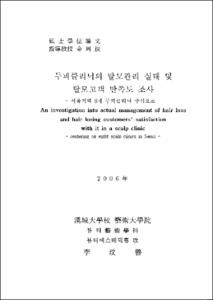두피클리닉의 탈모관리 실태 및 탈모고객 만족도 조사
- Files in This Item:
-
-
Download
 000000556995.pdf
기타 데이터 / 1.94 MB / Adobe PDF
000000556995.pdf
기타 데이터 / 1.94 MB / Adobe PDF
-
Items in Repository are protected by copyright, with all rights reserved, unless otherwise indicated.
 000000556995.pdf
기타 데이터 / 1.94 MB / Adobe PDF
000000556995.pdf
기타 데이터 / 1.94 MB / Adobe PDFItems in Repository are protected by copyright, with all rights reserved, unless otherwise indicated.